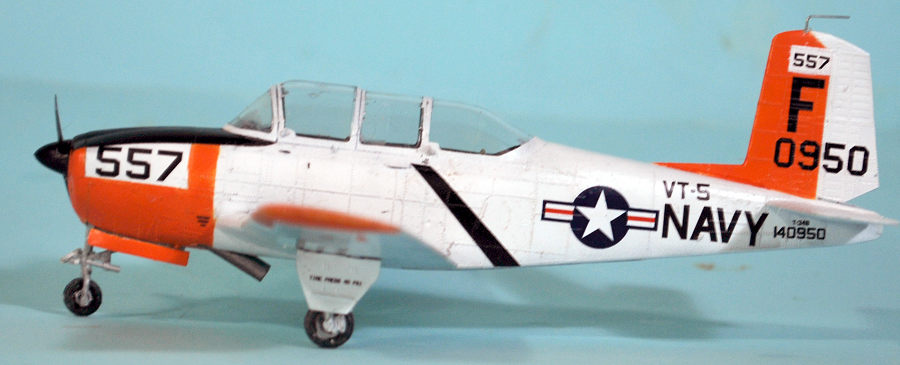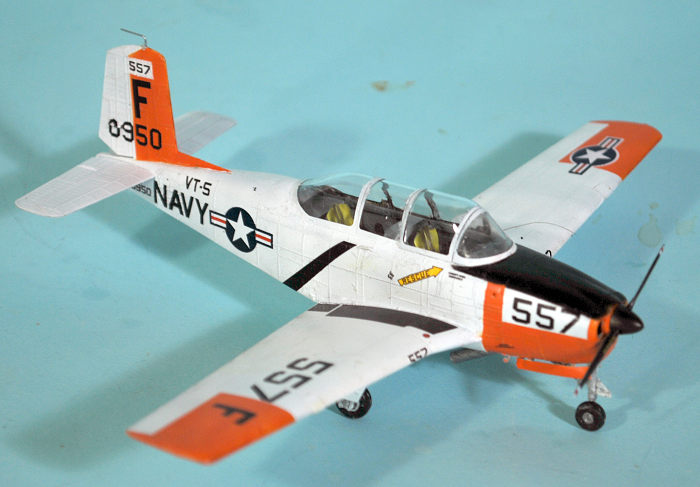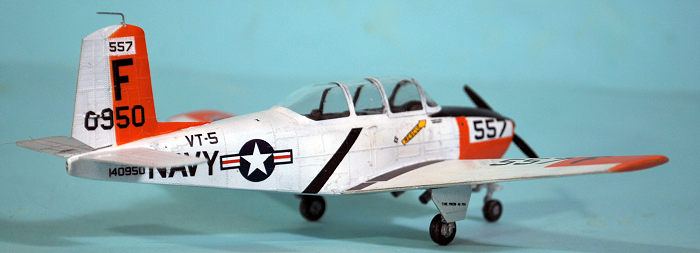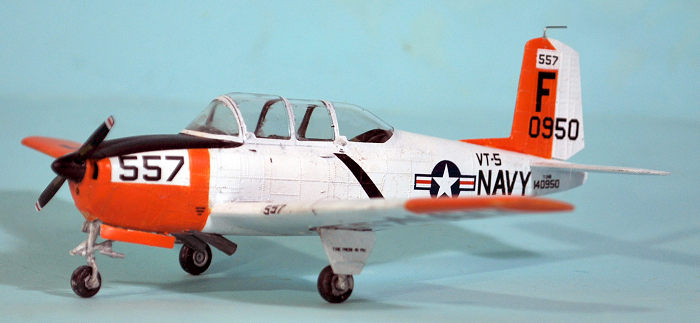
Academy 1/48 T-34B Mentor
| KIT #: | 12361 |
| PRICE: | $27.00 |
| DECALS: | Three options |
| REVIEWER: | Tom Cleaver |
| NOTES: | Ex-Minicraft tooling |

| HISTORY |
The T-34 was the brainchild of Walter Beech, who developed it as the Beechcraft Model 45 private venture at a time when there was no defense budget for a new trainer model. Beech hoped to sell it as an economical alternative to the North American T-6/SNJ Texan, then in use by all services of the U.S. military.
Three initial design concepts were developed for the Model 45, including one with the Bonanza's signature V-tail, but the final design that emerged in 1948 incorporated conventional tail control surfaces for the benefit of the more conservative military, featuring a relatively large unswept vertical fin that would find its way onto the Travel Air twin-engine civil aircraft almost ten years later. The Bonanza's fuselage with four- passenger cabin was replaced with a narrower fuselage incorporating a two-seater tandem cockpit and bubble canopy, which provided greater visibility for the trainee pilot and flight instructor. Structurally, the Model 45 was much stronger than the Bonanza, being designed for +10g and −4.5g, while the Continental E-185 engine of 185 horsepower at takeoff- less than a third of the power of the T-6's engine - was the same as that fitted to contemporary Bonanzas.
Following the prototype were three Model A45T aircraft, the first two with the
same engine as the prototype and the third with a Continental E-225, which would
prove to be close to the production version. Production did not begin until
1953, when Beechcraft began delivering T-34As to the United States Air Force and
similar Model B45 aircraft for export. Production of the T-34B for the United
States Navy began in 1955, this version featuring a number of changes reflecting
the different requirements of the two services. The T-34B had
 only
differential braking for steering control on the ground instead of nosewheel
steering, additional wing dihedral and, to cater for the different heights of
pilots, adjustable rudder pedals instead of the moveable seats of the T-34A.
T-34A production was completed in 1956, with T-34Bs being built until October
1957 and licensed B45 versions built in Canada, Japan, and Argentina until 1958.
Beechcraft delivered the last Model B45s in 1959. Total production of the
Continental-engined versions in the US and abroad was 1,904 aircraft.
only
differential braking for steering control on the ground instead of nosewheel
steering, additional wing dihedral and, to cater for the different heights of
pilots, adjustable rudder pedals instead of the moveable seats of the T-34A.
T-34A production was completed in 1956, with T-34Bs being built until October
1957 and licensed B45 versions built in Canada, Japan, and Argentina until 1958.
Beechcraft delivered the last Model B45s in 1959. Total production of the
Continental-engined versions in the US and abroad was 1,904 aircraft.
The U.S. Navy kept the T-34B operational as a Naval Air Training Command initial primary trainer at the former Naval Air Station Saufley Field, Florida until the mid-1970s and as a Navy Recruiting Command aircraft until the early 1990s when the last examples were retired as an economy move. Others continue to remain under U.S. Navy control as part of flying clubs at naval air stations and Marine Corps air stations.
The T-34B was used as a trainer by Algeria, Argentina, Bolivia, Canada, Chile, Colombia, Ecuador, El Salvador, France, Gabon, Indonesia, Japan, Mexico, Morocco, Peru, Philippines, Saudia Arabia, Spain, Taiwan, Turkey, United States, Uruguay, and Venezuela.
In 2004, due to a series of crashes involving in-flight structural failure during simulated combat flights, the entire US civilian fleet of T-34A/Bs was grounded by the Federal Aviation Administration. The grounding has since been eased to a slate of restrictions on the permitted flight envelope. Via a series of Airworthiness Directives (ADs) established by or Alternate Methods of Compliance (AMOCs) negotiated with the FAA, including installation of certain, approved structural modifications to the wing spar and other repairs, the T-34A and T-34B fleet in 2011 has been restored to full flight status by FAA at the Mentor's originally designed limitations, provided each individual example is compliant with those ADs and AMOCs.
| THE KIT |
Minicraft first brought out a USAF T-34A Mentor in 2018, following that with a re-relase with markings for the YT-34 prototype in 2019, and a “yellow peril” Navy T-34B in 2020. The molds were then sold to or leased by Academy (who might have done the originals for Minicraft and repossessed them following the demise of Minicraft), which has now brought out a T-34B with markings as both a “yellow peril” and the final white/orange scheme for Navy Mentors.
Trainers are seldom done since they lack the “bang-bang” feature too many
modelers think is a requirement for a kit of any airplane, ship or land vehicle.
Minicraft’s choice of the T-34 was thus out of the ordinary. Luckily, with o ne
major detail exception, they mostly “got it right,” and overall it is a very
nice kit with raised rivet molding that is scale-appropriate along with other
surface detail that really makes the final result “pop.” The three clear parts
of the canopy cannot be posed open due to thickness of the plastic, but in the
Academy release these parts are so clear one has no problem viewing the
interior.
ne
major detail exception, they mostly “got it right,” and overall it is a very
nice kit with raised rivet molding that is scale-appropriate along with other
surface detail that really makes the final result “pop.” The three clear parts
of the canopy cannot be posed open due to thickness of the plastic, but in the
Academy release these parts are so clear one has no problem viewing the
interior.
The cockpit is simple, but then the real cockpit is simple too. Instrument panels are decals, which look fine with the canopy closed.
The one real problem is that - as with many other kit manufacturers, Minicraft/Academy got the landing gear legs wrong, producing them in full-extension. There is really nothing to be done other than to cut the legs (they are about 1/8 inch too long)in the oleo section and glue them together with the oleo scissors more closed. Otherwise the finished model sits way too high. Fortunately, this is an easy fix.
The Academy release features decals for an orange-white T-34B with VT-5 in 1974, the final period of use of piston-engine Mentors by the Navy; an orange-white T-34B in VT-5 markings used for publicity in 1984 after the T-34Bs were removed from service; and a “yellow peril” T-34B of VT-5 in the late60s. The decals are well printed, but the white backing for the wing insignia is a bit thin and noticeable when placed over deep red-orange; I found the solution was to use the alternative national markings decals over those, to make the insignia more opaque, which also makes the white surround look more opaque though nothing has been done to it.
| CONSTRUCTION |
 Starting with
the cockpit, I painted everything Dark Gull Grey other than the seat pads, which
I painted yellow. I then applied the instrument panel decals and assembled the
cockpit. I used Eduard seat belts as the only non-OOB item.
Starting with
the cockpit, I painted everything Dark Gull Grey other than the seat pads, which
I painted yellow. I then applied the instrument panel decals and assembled the
cockpit. I used Eduard seat belts as the only non-OOB item.
I crammed the nose as full of squeezed fishweights as possible. In the end it is a nose-sitter, but will tail-sit with just a tap. I didn’t realize the landing gear was too long until I was assembling it into the wing. I ended up using clippers to cut off the lower ends, and then cutting off and squeezing the oleo scissors. The gear needs to be reduced in length 1/8 inch.
| COLORS & MARKINGS |
 I applied some
dark gray over the rivet lines, so that when I painted the gloss white, the
rivets would be a bit visible, as on the real airplane where grime can be seen
around raised rivet heads. I then masked off the white and shot the orange,
which I mixed from Tamiya Orange and Gloss Red. I put in more orange to lighten
it and went over the areas to simulate wear since the orange paint in these
markings oxidizes. I then masked off the nose and painted the antiglare with
Tamiya Flat Black.
I applied some
dark gray over the rivet lines, so that when I painted the gloss white, the
rivets would be a bit visible, as on the real airplane where grime can be seen
around raised rivet heads. I then masked off the white and shot the orange,
which I mixed from Tamiya Orange and Gloss Red. I put in more orange to lighten
it and went over the areas to simulate wear since the orange paint in these
markings oxidizes. I then masked off the nose and painted the antiglare with
Tamiya Flat Black.
The decals are very thin. You need to have the area where they will go covered in water or they will settle immediately. All the decals went down without problem under a coat of Micro-Sol. As I mentioned above, I used the extra national marking to take care of the opacity problem of the thin decals over the orange area.
I attached the landing gear (a difficult moment to notice the gear length problem, but still easily solved), attached the prop and the exhausts, and unmasked the canopy.
| CONCLUSIONS |
I like the Mentor for two reasons: I like Beech Bonanzas, having once been part owner of a 1947 “straight” Model 35 that was still aerodynamically more modern than any Cessna on the line 30 years after it was built. I also had some “Mentor time” with a friend who owned one in the late 70s. You don’t have to have such a personal connection to like this kit. The Mentor was an important trainer, and this is a very nice kit of it. Recommended for any skill level - it’s an easy kit.
Review kit courtesy of you book buyers.
17 November 2023
Copyright ModelingMadness.com. All rights reserved. No reproduction in part or in whole without express permission.
If you would like your product reviewed fairly and fairly quickly, please contact the editor or see other details in the Note to Contributors.